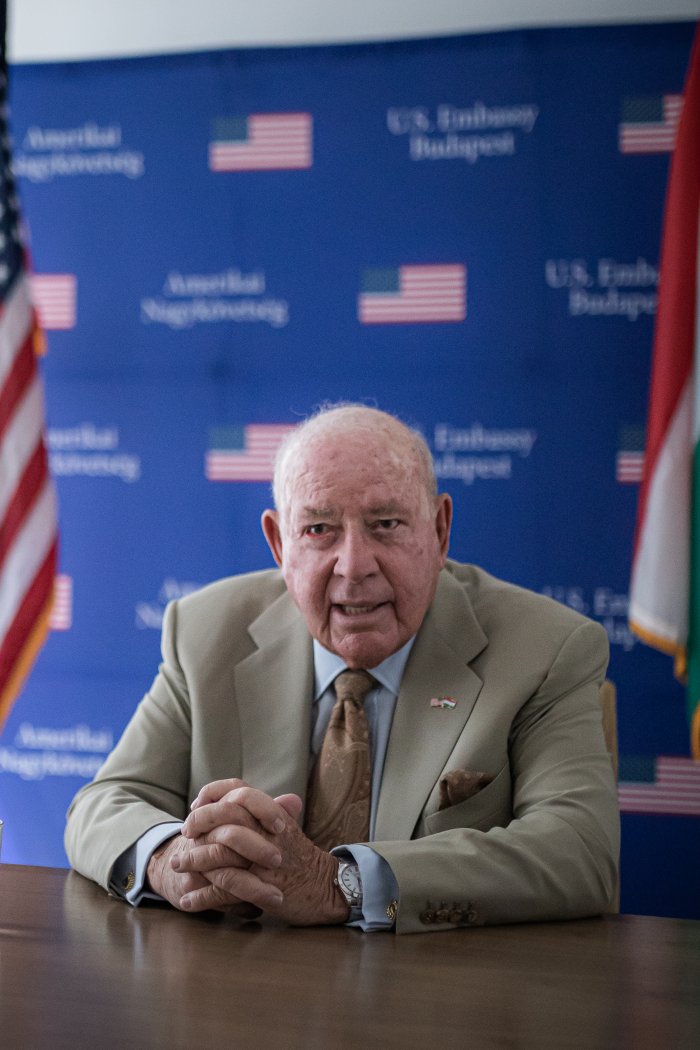Reveling in the ‘Purity’ of Hungarian (and U.S.) Numbers

Árpád Pintér/BBJ
In his first exclusive interview with the Budapest Business Journal, U.S. Ambassador David B. Cornstein reflects on his first year in office, the strength of bilateral relations, how the States and Hungary are coping with a “high class problem”, and his number one priority.
U.S. Ambassador David B. Cornstein. Photo by Árpád Pintér/BBJ
In one of his fist public appearances after he officially took up post on June 25, 2018, Cornstein joked at an American Chamber of Commerce event that, in order to become ambassador, first you have to live long enough to get through the selection process.
“Well, I did live long enough to get through the process, and now I have lived long enough to have a year’s anniversary, and I thank God for both,” he tells the BBJ with a chuckle.
With a background in business, he says his experience of CEOs is that one good quarter of results will see them exaggerating the good news, while poor figures are blamed on the business cycle, the weather or whatever.
“The one thing that never really exaggerates or you have to explain is a number. Numbers are very pure and the numbers here show a very high class problem, and it is one we are experiencing in the United States as well, that of having a very strong economy,” he says.
“Things are good; things could always be better, but the atmosphere for conducting business here is quite good.”
Biggest Drawback
The second element of that “high class problem” is “exceptionally low unemployment”, and that represents just about the only fly in the ointment, the ambassador says. “The biggest drawback for me to attract American companies to come to Hungary is to find workforce for those companies.”
Cornstein says more should be done to expand the number of women in the workforce, and to attract “the right kind of immigrants into the country”. He acknowledges that higher salaries among neighboring countries has been a problem for Hungary, but points out wages have been on the rise.
He says the American companies he visits in Hungary are “very happy either selling their products or providing their services here [….]. The main problem is the labor force; I think they could grow more, but they do not have the workers.”
There is one other area of concern, one the ambassador says he shares with President Donald Trump (though it affects more countries than just Hungary), and that is “the balance of trade between the United States and our allies and friends”. [See separate story on the U.S.-Hungary Economic Relationship, Page 13.] One possibility for closing that trade gap, and also for Hungary to meet EU and NATO commitments for spending 2% of GDP on the armed forces, is military procurements, the ambassador says. Hungary recently announced it is considering replacing its fleet of Saab JAS 39 Gripen fighter aircraft, and whether on a lease or purchase basis, the Lockheed Martin F-35 Lightning II Stealth Fighter would certainly be a replacement option.
“I am not actually a pilot, but I am told it the superior aircraft of choice,” Cornstein says, pointing out that it is also already in service or on order with many NATO allies.
Robust Relationship
The bilateral relationship is now extremely robust, the ambassador says. “I think that is one of the things we at the embassy are most proud of in this past year,” he explains.
“The strategy of the previous Washington administration was basically not to have any relationship at all with the government of Hungary, because they did not agree with a lot of what they perceived was happening here.
“I do not believe in that; Secretary [Mike] Pompeo does not believe in that; President Trump does not believe in that. [….] We have done a lot to try to improve the relationship. The highlight, of course, was the meeting at the White House between Prime Minister [Viktor] Orbán and President Trump, but we have had Secretary of State Pompeo to visit, and Secretary of Energy Rick Perry. On the American side, we have shown how important it is to us to have a [strong] relationship with this wonderful country.”
The ambassador says he believes Hungary, which he describes as “Europe’s best-kept secret”, has suffered from not doing enough to get its message out – he is delighted the government has finally followed his advice and hired two international PR companies – and from the way large sections of America’s press view Orbán.
“It is both. They are not getting the message across. I do not think I have read a positive article about Budapest or Hungary. And a strong conservative leader does not play particularly well with the liberal press such as the New York Times or the Washington Post.”
He describes Orbán as a friend, and says he has not met one member of the government he does not like.
“Does that mean we see eye-to-eye on everything? No, but then I did not with my parents, God rest their souls, and I do not my wife, or my son, and I certainly don’t with the Prime Minister. But we are friends. The relationship works. It works for America and for Hungary.”
Great Institution
One example of not seeing eye-to-eye remains the Central European University. When he arrived he said keeping the university here was his number one priority. When the government changed the rules for foreign accredited universities, many felt it was aimed at the CEU, which was founded by George Soros, the U.S.-Hungarian financier, investor and philanthropist who holds diametrically opposed views to the Fidesz-led government. The government has always denied it is targeting CEU, but the university insists it is being chased out of Hungary, and from this September its freshman U.S. students will study in Vienna.
“When and if it does move down the road [to Vienna] I will be very sad [….]. It is a great institution, a great institution for Hungary. I would love to see the status quo remain. Will it lead to long-term repercussions in the relationship? No, but I will be very sad to see it go.”
The ambassador says his number one priority today is to see Hungary’s energy dependency on Russia reduced from its very high level of 85%, by opening up other sources of gas supply.
“Personally, I think the entire region, not just this country, would be better served by that,” he says. Although there are several plans floating around for new pipelines to bring gas to Europe, almost all would still have Russia as the source of the gas. Two exceptions are an LNG terminal for U.S. gas in Croatia, and the Black Sea reserves in Romania that U.S. company ExxonMobil is interested in extracting.
“Everyone I speak to in the U.S. government wants to see this [dependency reduced]. I had a conversation in the Oval Office with the President last week about this. [….] That’s why one of the alternatives, and hopefully both, has to materialize.”
He emphasizes that the “Hungarian government is not an obstacle in this. They understand how important this is.”
Taking a Select Crew to Market
The main reason for Ambassador Cornstein’s recent visit to Washington, D.C. was to lead a delegation of Hungarian business leaders to the SelectUSA Investment Summit, the highest-profile event dedicated to promoting FDI in the United States.
Convened by Secretary of Commerce Wilbur Ross and featuring top-level U.S. government and business leaders, the summit connects foreign firms directly with U.S. economic development organizations to facilitate business investment and job creation. Fifteen Hungarian companies were represented in its delegation to SelectUSA 2019.
“I was totally impressed with the summit,” says the businessman-turned-diplomat. “There were business people there from all over the world looking to expand their business into the U.S. market. I met the CEOs of all 15 Hungarian companies before we went over, and we were with them in Washington, of course. I was really impressed with the quality of the people, the products, services, innovations they have. I think they would be very welcome in the United States,” he adds.
With the strength of the economy, he says “this is a good time to come to the America. Hungary should have more companies there. I know I just took 15; 15 is a nice number compared to zero, but it could be 115. We have an incredible market; where else would you find a market like America? If you want to grow, that is the place to grow, for sure.”
For more information about SelectUSA, visit www.selectusasummit.us
The U.S.-Hungary Economic Relationship
The United States is the second largest investor in Hungary behind Germany, according to the latest June 2019 figures supplied by the U.S Embassy. American-based companies have invested more than USD 11 billion in Hungary and employ more than 100,000 Hungarians. Hungarian investment in the United States is small but growing.
Similarly, the United States is the largest consumer of Hungarian exports outside the EU. Hungary exports approximately USD 5 bln a year in goods to the United States. The United States exports around USD 1.7 bln to Hungary, leading to a roughly USD 3.3 bln trade deficit in Hungary’s favor.
Products
From 2017 to 2018, U.S. merchandise exports to Hungary decreased by 7.2%, but this is within the normal range of USD 1.7 bln-USD 1.8 bln that has been fairly consistent since 2013.
The United States continues to export machinery (turbojets) (34%); electrical machinery (18%); optical/medical instruments (9%); and vehicles (9%).
Over the last five years, U.S. machinery exports to Hungary have decreased, but increases in other important sectors such as optical/medical instruments, aircraft parts, and pharmaceuticals goods have increased, leading to a stable trade relationship.
From 2017 to 2018, U.S. merchandise imports from Hungary remained the same (USD 5.1 bln).
From 2013 to 2018, U.S. merchandise imports from Hungary increased from USD 3.8 bln to USD 5.1 bln, or 34%.
Services
U.S. services exports to Hungary have seen an increase from USD 0.9 bln to USD 1.1 bln between 2015 and 2017.
U.S. services imports from Hungary have increased from USD 0.8 bln to USD 1 bln between 2015 and 2017.
There is thus a healthy two-way services trade relationship between the two countries.
Agriculture
In 2018, U.S. agricultural exports to Hungary totaled USD 40.3 million and U.S. imports of Hungarian products totaled USD 54.8 mln.
Major U.S. exports to Hungary include planting seeds, prepared foods, and protein concentrates. Major Hungarian exports to the United States include down stuffing feathers, essential oils, and processed fruit and vegetables.
SUPPORT THE BUDAPEST BUSINESS JOURNAL
Producing journalism that is worthy of the name is a costly business. For 27 years, the publishers, editors and reporters of the Budapest Business Journal have striven to bring you business news that works, information that you can trust, that is factual, accurate and presented without fear or favor.
Newspaper organizations across the globe have struggled to find a business model that allows them to continue to excel, without compromising their ability to perform. Most recently, some have experimented with the idea of involving their most important stakeholders, their readers.
We would like to offer that same opportunity to our readers. We would like to invite you to help us deliver the quality business journalism you require. Hit our Support the BBJ button and you can choose the how much and how often you send us your contributions.











